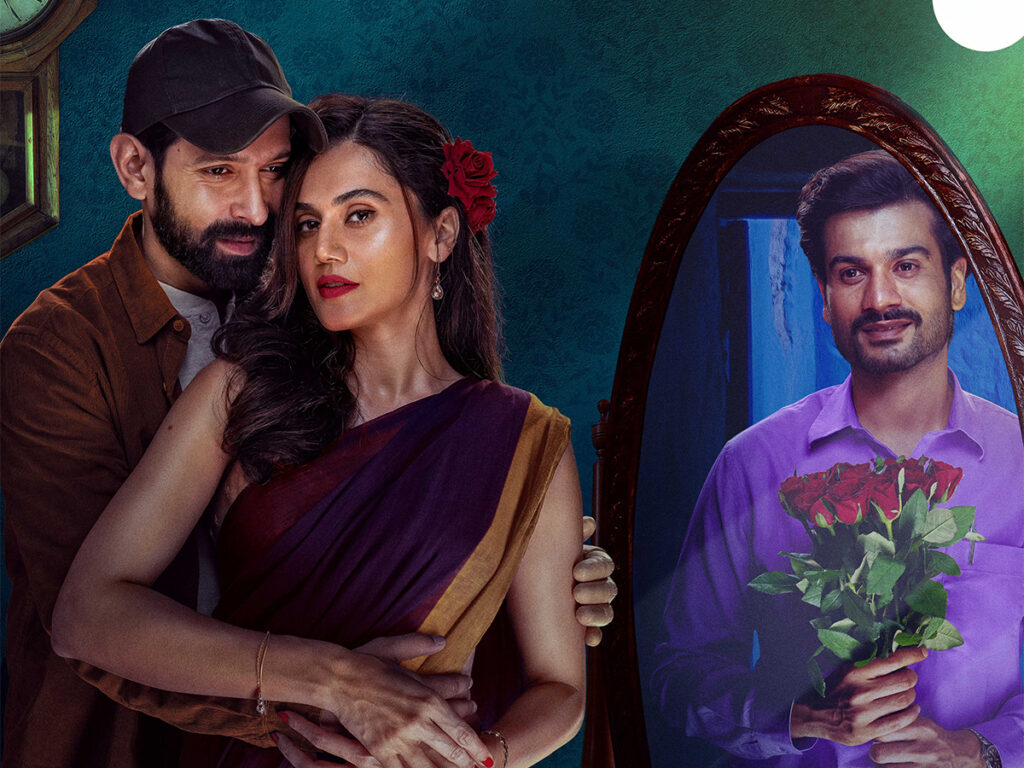Jayprad Desai’s Phir Aayi Hasseen Dillruba, currently streaming on Netflix, is a sequel to the 2021 film, Hasseen Dillruba, directed by Vinil Mathew. This time, the addition of two new characters into this cat-and-mouse story attempts to ratchet up the suspense and also puts more obstacles in the paths of the two principal characters. However, instead of keeping one glued to the edge of one’s seat, the film runs out of steam midway losing and never really recovers after that.
As the film begins, Rani (Taapsee Pannu) has now settled in Agra as a widow and stays in a rented house while Rishu (Vikrant Massey) is a fugitive from the police and lives in the same city under an alias. They meet clandestinely in various locations of the city and remain connected through phone calls. Rishu, through the help of a travelling agent, wants to escape to Thailand along with Rani. Meanwhile, a young medical compounder, Abhimanyu Pandit (Sunny Kaushal), is smitten by Rani and wants to date her but sadly for him, Rani does not show much interest in him. Coincidentally, ACP Kishore Rawat (Aditya Srivastava) is also transferred to Agra and he asks Mrityunjay Paswan aka Monty Chacha (Jimmy Shergill) to investigate the case of his missing nephew, Neel (Harshvardhan Rane). Monty suspects that the burnt dead body of Rishu, found in the house in the prequel, is actually that of Neel. He summons Rani to the police station, asking her about the whereabouts of Rishu. As Rani feels that her relationship with Rishu is threatened, she decides to marry Abhimanyu in order to fool the police…
From the onset, Phir Aayi Hasseen Dillruba takes great pleasure in building up plot devices to churn out one moment after the other at breakneck speed thereby sacrificing emotional investment in the characters. The key moment in the film – when Rani proposes to marry Abhimanyu – is handled so hurriedly, it criminally lacks the buildup needed for us to support her decision. The scene where Rani, in a state of alcoholic stupor, reveals to Abhimanyu that Rishu is alive also suffers from the same negligence. In fact, Kanika Dhillon’s screenplay is more invested in one-liners and convoluted dramatic moments instead of fully developing the characters or advancing the story in a convincing manner. For instance, Abhimanyu’s dark past and the circumstances of his family members’ deaths is inadequately unexplored, making it seem more like a passing remark and little else. Had it been developed with more depth, it could have added significant heft to his character as well as to the narrative. Even the climax seems to drag and appears as if the makers were in a hurry to fill up the two-hour slot of the film.
Taapsee Pannu brings much seductive charm to her character and raises it a notch this time, performance wise. In the more emotional moments of the film, she maintains depth and a captivating intensity. Vikrant Massey nicely captures the indomitable spirit of a lover who refuses to let obstacles jeopardize his relationship with Rani. However, as an individual with artificial limbs, he fails to convey the nuances and difficulties of having to live as a differently abled person. Sunny Kaushal performs with conviction, deftly balancing his agony and madness. Bhumika Dubey shines in her supporting act but Aditya Srivastava finds himself reduced to a one-dimensional, underwritten character this time, lacking the mojo he displayed in the prequel. Jimmy Shergill also finds himself caught up in a characterisation that does him no favours. Though Montu Chacha is called ‘woodpecker’ in the department supposedly because of his habit of persistently pecking at the case until he solves it, we don’t really see him making any concrete effort to nab Rishu, whom he suspects to be alive. He is also never shown to have the acumen to solve an issue unless he is helped by an external force.
Vishal Sinha’s noirish cinematography somewhat compensates for the weaker aspects of the film . The editing by Hemal Kothari captures the pulse of the narrative perfectly, creating a smooth overall rhythm and pace through the film’s entire running. Sadly, the film is treated with little scope given for an effective sound design but Anurag Saikia’s background score does help greatly to fill up the film’s shortcomings. Especially since the songs in the film are not melodious and fail to leave a lasting impact. Nikhil Kovale’s production design displays an eye for detail that goes well with the film’s pulpy story.
As a hard-boiled crime drama, Phir Aayi Hasseen Dillruba embraces its genre conventions but succeeds only partially. A more controlled approach to the thrills, twists and turns would have worked better for the narrative rather than merely relying on some misleading developments. All in all, the film is unable to sustain, making its overall viewing experience rather dissatisfying.
Thriller, Drama, Color


